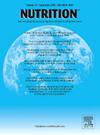Effects of integrative telehealth-based nutrition care with and without oral nutritional supplements in patients with liver and colorectal cancer: A randomized controlled trial
IF 3.2
3区 医学
Q2 NUTRITION & DIETETICS
引用次数: 0
Abstract
Objectives
This study investigated the effects of post-discharge integrative telehealth-based nutritional care alone versus post-discharge integrative telehealth-based nutritional care combined with high-calorie/high-protein oral nutritional supplements (HCHP-ONS) on the nutritional status and quality of life in patients with hepatocellular carcinoma (HCC) or colorectal cancer (CRC) at risk of malnutrition.
Methods
We recruited HCC or CRC patients who were at moderate to high risk of malnutrition, defined as a score of 4–9 on the abridged Patient-Generated Subjective Global Assessment (aPG-SGA), and randomly assigned them to either a telehealth nutritional care-control group (C group) or a telehealth nutritional care combined with HCHP-ONS group (C+O group) for a 3-month intervention. In group C, a dietitian provided monthly telehealth-based nutritional assessments and guidance through a mobile application (LINE) or phone calls. In the C+O group, in addition to telehealth-based nutritional assessments and guidance, patients received a daily can of HCHP-ONS, which provided 425 kcal and 19.1 g of protein per serving. Blood tests, anthropometric indicators, the European Organization for Research and Treatment of Cancer Quality of Life Questionnaire (EORTC QLQ-C30) and a nutritional status assessment were conducted monthly.
Results
Results showed that the C+O group had significantly reduced malnutrition risk scores at the 1st, 2nd, and 3rd months. By the 3rd month, the C+O group showed significant improvement in the Prognostic Nutritional Index (PNI), and notable improvements in diarrhea and respiratory distress scores.
Conclusions
In patients with HCC and CRC who were at risk of malnutrition, integrative telehealth-based nutritional care via LINE or phone calls effectively reduced malnutrition risk, maintained PNI, and supported quality of life (QOL). The addition of HCHP-ONS further enhanced nutritional outcomes, leading to greater improvements in PNI, diarrhea, and dyspnea by the 3rd month.
有或没有口服营养补充剂的综合远程保健营养护理对肝癌和结直肠癌患者的影响:一项随机对照试验
目的探讨出院后综合远程医疗营养护理与出院后综合远程医疗营养护理联合高热量/高蛋白口服营养补充剂(HCHP-ONS)对有营养不良风险的肝细胞癌(HCC)或结直肠癌(CRC)患者营养状况和生活质量的影响。方法招募营养不良中度至高危的HCC或CRC患者,定义为在简化的患者主观整体评估(aPG-SGA)中得分为4-9分,随机分配到远程医疗营养护理对照组(C组)或远程医疗营养护理联合HCHP-ONS组(C+O组)进行为期3个月的干预。在C组,一名营养师每月通过移动应用程序(LINE)或电话提供基于远程医疗的营养评估和指导。在C+O组中,除了基于远程医疗的营养评估和指导外,患者每天还接受一罐HCHP-ONS,每份提供425千卡和19.1克蛋白质。每月进行血液检查、人体测量指标、欧洲癌症研究和治疗组织生活质量调查表(EORTC QLQ-C30)和营养状况评估。结果结果显示,C+O组在第1、2、3个月时营养不良风险评分显著降低。到第3个月,C+O组预后营养指数(PNI)显著改善,腹泻和呼吸窘迫评分显著改善。结论对于存在营养不良风险的HCC和CRC患者,通过LINE或电话进行综合远程健康营养护理可有效降低营养不良风险,维持PNI,支持生活质量(QOL)。hhp - ons的加入进一步改善了营养结果,导致PNI、腹泻和呼吸困难在第3个月有更大的改善。
本文章由计算机程序翻译,如有差异,请以英文原文为准。
求助全文
约1分钟内获得全文
求助全文
来源期刊

Nutrition
医学-营养学
CiteScore
7.80
自引率
2.30%
发文量
300
审稿时长
60 days
期刊介绍:
Nutrition has an open access mirror journal Nutrition: X, sharing the same aims and scope, editorial team, submission system and rigorous peer review.
Founded by Michael M. Meguid in the early 1980''s, Nutrition presents advances in nutrition research and science, informs its readers on new and advancing technologies and data in clinical nutrition practice, encourages the application of outcomes research and meta-analyses to problems in patient-related nutrition; and seeks to help clarify and set the research, policy and practice agenda for nutrition science to enhance human well-being in the years ahead.
 求助内容:
求助内容: 应助结果提醒方式:
应助结果提醒方式:


